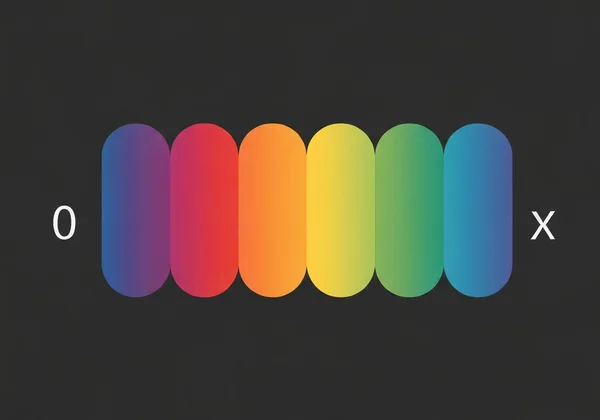The Kinsey Scale: Navigating Feelings & Identity After Your Score
Congratulations on taking a step toward deeper self-understanding with the kinsey scale test! Seeing your score can bring up a wave of emotions—perhaps relief, a sense of validation, or even a bit of confusion. Whatever you're feeling right now is completely valid. For many, the big question becomes: What do my results mean for me? This guide is here to offer a compassionate space to help you navigate these feelings and empower you on your personal journey of self-discovery.
Your exploration is a personal and unique process. At our platform, we provide tools for reflection, and this article is the next step in that journey. If you're ready to begin, you can always revisit the experience and start your journey on our homepage.

Common Feelings After Your Kinsey Score
Receiving a number meant to reflect something as personal as sexual orientation can be a profound experience. It’s common to feel a mix of things, and none of them are wrong. Recognizing and sitting with these emotions is the first step toward understanding what your score means to you.
Understanding Confusion & Uncertainty
Navigating emotional responses to your score can feel complex. You might have expected a different number, or perhaps the result doesn't feel like it captures the whole picture. This is perfectly normal. Human sexuality is intricate and multi-faceted, and the Kinsey Scale is a simplified model from the 1940s. Confusion doesn't mean the test is wrong or that your feelings are invalid; it often signals an opportunity for deeper introspection. It might be prompting you to think about attraction, behavior, and fantasy in new ways, which is a core part of the self-discovery process.
Embracing Relief & Validation
For many, seeing their score brings a powerful sense of relief. It can feel like a quiet affirmation of feelings you've held for a long time but couldn't quite name. Finding self-acceptance is a crucial part of personal growth, and your Kinsey score can be a validating tool in that process. It can serve as an external reference point that says, "You are not alone; there is a place for you on this spectrum." This feeling of validation can be incredibly empowering, giving you the confidence to own your identity more fully and authentically.
What if More Questions Arise?
Sometimes, an answer only leads to more questions. This is not a setback; it’s a sign of progress. The Kinsey test is often not the end of a journey but the start of personal growth. Your score might spark curiosity about sexual fluidity, the differences between romantic and sexual attraction, or how your identity fits into the broader LGBTQ+ community. Embrace these questions. They are your mind’s way of inviting you to explore your inner world more deeply, and resources like our Kinsey Scale exploration are designed to support that curiosity.
Practicing Self-Compassion in Your Journey
As you process your results, one of the most important tools you can use is self-compassion. This means treating yourself with the same kindness and understanding you would offer a good friend. Your journey of exploring my identity is yours alone, and there is no "right" way to feel or a correct timeline to follow.
Remembering Identity is a Journey, Not a Destination
It’s tempting to look for a final, fixed answer about who we are. However, it's more helpful to view identity as a flowing river, not a static monument. Understanding identity fluidity means recognizing that your feelings, attractions, and even how you identify can evolve throughout your life. Your Kinsey score is a snapshot of where you are right now. It is a helpful guidepost, but it does not dictate the path ahead. Allow yourself the grace to grow and change, knowing that every step is part of your authentic journey.

Why Your Score Isn't a Permanent Label
In a world that loves labels, it's easy to see your Kinsey score as a permanent tag. We must move beyond a simple score. The number you received is not a definitive diagnosis or a box you must fit into for the rest of your life. It is a tool for reflection. Its purpose is to help you think critically about your own experiences and feelings. Resisting the pressure to treat it as an unchangeable label frees you to continue exploring your identity with openness and curiosity. You get to define what your score means to you, not the other way around.
Next Steps: Gently Exploring Your Identity
So, what comes next? After processing your initial feelings and embracing self-compassion, you can take gentle, proactive steps to continue your self-discovery guide. This phase is all about curiosity and gentle exploration, not pressure or expectation.
Deepening Reflection on Your Kinsey Results
Your score is just the beginning. To truly understand its significance, it's helpful to reflect on the experiences that led to it. Consider the questions you answered about attraction, behavior, and fantasy. Gaining deeper insights comes from connecting the dots between the test and your lived experiences. For a more structured reflection, we offer an optional AI-powered personalized analysis. This report goes beyond the single number to provide nuanced interpretations that can help you understand the complexities of your results. You can unlock your AI report to take your understanding to the next level.
Finding Trusted Support & Resources
You don’t have to navigate this journey alone. Building a support system can make all the difference. This could mean talking to a trusted friend, a partner, or a family member who you know will be supportive and non-judgmental. Sharing your thoughts can help you process them and feel less isolated. You might also consider exploring online communities or local LGBTQ+ resource centers. These spaces can connect you with others who have similar experiences, providing a sense of community and shared understanding.

Embrace Your Unique Kinsey Journey
Taking the Kinsey Scale test is a courageous act of self-exploration. The feelings and questions that arise afterward are a natural and essential part of the process. Remember that your score is a tool, not a label. It's a single point of data in the rich, complex, and beautiful story of who you are.
Your journey is valid, your feelings are important, and you have the power to define yourself on your own terms. Continue to approach your identity with curiosity, kindness, and compassion. We encourage you to use our platform as a resource for your ongoing journey. Continue your exploration whenever you feel ready to learn more about yourself.
Frequently Asked Questions About Post-Kinsey Feelings
How does the Kinsey Scale work, and is it accurate for me?
The Kinsey Scale is a 7-point scale (plus an "X" category for no socio-sexual contacts or reactions) that classifies sexual orientation based on a person's experiences and responses regarding attraction and behavior. While groundbreaking for its time, it's important to remember it's a simplified model. Its "accuracy" is less about being a clinical diagnosis and more about how well it serves you as a tool for personal reflection. Its real value lies in helping you frame your own experiences on a spectrum.

What does a score of 3 on the Kinsey Scale mean for my identity?
A score of 3 on the Kinsey Scale indicates being equally heterosexual and homosexual in experience or inclination. However, this is just a general definition. What it means for your identity is entirely up to you. It might align with identifying as bisexual or pansexual, or you may prefer not to use a specific label at all. The score provides a language for your feelings, but you are the ultimate authority on your own identity. You can explore the Kinsey Scale further on our site to understand each score.
Can my feelings about my sexuality or my Kinsey score change over time?
Absolutely. Sexuality can be fluid, meaning a person's attractions and identity can shift and change over their lifetime. The score you receive today might be different from a score you would get five years from now, and that is completely okay. This fluidity is a natural part of the human experience for many people.
When should I seek professional support for my identity questions?
While online tools and self-reflection are valuable, seeking professional support from a therapist or counselor, especially one specializing in LGBTQ+ issues, is a great idea if you feel overwhelmed, distressed, or simply want a dedicated space to explore your identity. A professional can provide personalized guidance and support that goes beyond what any article or test can offer.
What are alternatives to the Kinsey Scale for understanding sexual orientation?
The Kinsey Scale is a foundational tool, but other models offer different perspectives. The Klein Sexual Orientation Grid, for example, expands on Kinsey's work by measuring seven different dimensions of sexuality (like attraction, behavior, fantasies, and social preference) and considers that they can change over time. Exploring these alternatives can provide an even more comprehensive view of your unique identity.